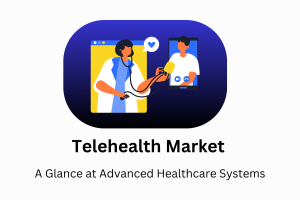Technology has touched every aspect of human existence. World amenities are accessible to us at the ease of our fingertips, telehealth is one of those high-tech marvels. The telehealth market has gained a swift uptake in the recent past. One need not travel to a clinic and spend time in waiting rooms as digital consultation is here. Telehealth solutions have seen positive growth throughout the Covid-19 pandemic. It’s likely to remain a key term in global discussion even in the future.

Healthcare data is anticipated to remain a crucial asset in the highly integrated telehealth market. Patient data can be shared with clinical experts in the online sessions making the healthcare sector inclusive. Telehealth is especially effective in rural regions and remote healthcare services. The rising threat of CVDs, demands quality medical services. Growing education on remote patient monitoring led to telehealth market growth in the recent past.
The global telehealth market is estimated to surpass USD 52,897.2 Million by the end of 2025. The industry is likely to grow with a lucrative CAGR of 15.7% from 2018 to 2025. The estimated statistics are attributed to the impact of Covid-19. The course of the pandemic has increased the exposure of telehealth to a wider base. The telehealth industry is seen to have promising growth potential. The trend has gained the attention of industry experts.

Growth of Telehealth Market During and Post Covid-19 Pandemic
It was after covid-19 pandemic that telehealth got skyrocketed attention across the globe. Before the pandemic, telehealth was limited to only mental health providers. The pandemic has introduced telehealth to a wider audience. This applies across all other disciplines. Telehealth services grew with the extension of the lockdown. Patients are treated with telephone care and remote patient monitoring (RPM). It aided in the early detection of disorders and helped health masters to address emergencies.
Progressive markets such as the US observed optimistic growth in telehealth. These provisions were adopted during and after post COVID-19 pandemic. American Medical Association found about 60% of Americans benefited due to telehealth systems. This study was carried out during the pandemic period to capture responses from patients and doctors. A significant shift in the US towards remote patient care solutions was observed post-pandemic.
Telehealth is Trending, but What Makes it Trending?

- Reliable Technology
Virtual reality is a key technology in the growing telehealth market. Educating and planning healthcare processes are easy to accomplish with VR. Virtual visits offer patient-doctor interaction. Patients can stay in the comfort of their homes. As a result, leading companies are investing in VR applications. They are opting for remote patient monitoring (RPM), AI, and Machine learning offers smooth user interaction.
- Prioritized Chronic Care Management
The lack of care plans can cost billions a year to healthcare companies. Investing in telehealth can address the cost issues plus it can improve patient engagement. Especially in case of chronic conditions such as Alzheimer’s, and Heart disease, lifestyle changes and preventive care play a crucial role. A large group of these patients may not take repeated prescriptions. They might miss their follow-ups. With telehealth, patients can manage frequent connections, and Get instant support from physicians. It is observed that small health problems cause major complexities leading to a rise in risk. A shifting focus on chronic care is foreseen to support the growth of the telehealth market.
- Increased Mental Health Awareness
World Health Organisation has noted a rise in mental health disorders in the last decade especially due to COVID-19 leading to depression and isolation. It disrupted mental health services in 93% of nations, calling for enduring actions. People who were receiving treatments faced shutdowns of clinics responding to which many therapists switched to video conferencing. This helped them to offer services in lockdown. Through video calls, they developed telepsychiatry- a progression that is likely to bring positive growth in the telehealth market in the future as well.
Many hospitals prefer telemedicine niche outsourcing. Hospitals outsourced dermatology, mental health, and neurology services. This is expected to drive digital health industry competition in the upcoming decade. telemedicine trends have expanded to acquire global reach and are seen as a means of trading globally. The potential revenue from this industry could bring upward growth driving the world economy and telehealth market.
Rise of Telehealth Market- A Panacea for Healthcare Staffing Problems
Telehealth has been a dynamic transformation in the healthcare industry. Ever since its introduction, it has addressed key challenges such as patient outcomes and healthcare staffing. A shortage of qualified healthcare experts is one of the limiting factors ahead of global healthcare giants affecting their competencies. This gap further gets wider in rural areas generating a supply demand crunch.
Telehealth has solved the staffing issue to a great extent by allowing remote connections and convenience. This is visible from the rising number of telehealth nursing jobs in recent years. It has further helped companies retain and recruit experts. They can employ the best talent by offering them a work-life balance. Tele-nurse is one of the occupations growing in the digital health domain.
Role of Social Media in Telehealth Access
The digital revolution enables instant connections and conversation. The rapidly expanding digital landscape has been influencing regular medical practices. As per the World Health Organisation (WHO), any process that gives greater control to people to make their health decisions is “Patient Empowerment”. Social media enabled patient empowerment. Patients have sufficient control over social media. Novel mobile applications in telehealth terms as “mHealth”. These are widely in use. The M-health market is expected to grow with lucrative space in the future. WhatsApp is a common application helping patients to book appointments. It helps them to communicate with doctors. It’s no longer a secret, that social media is one of the trending telehealth tools. But its sureness and role remain the subject of research.
The Emergence of Smart Hospitals Accompany Some Challenges

Advanced economies have emphasized on creation of smart hospitals. Electronic health record systems (EHR) are being used to assist in the clinical workflow. Management of day-to-day tasks and improving patient care systems. Patients are treated within reduced waiting time. This is possible with the use of EMR software. EMR can work on patient scheduling and lab integration. EHR can manage prescriptions and medical billing. It can seamlessly handle them all. EMR’s software is expected to cross a valuation of USD 20,318.02 Million by the end of 2028. North America holds a dominant market share at present. The region has developed a health foundation. High digital literacy in America contributes to the penetration of the telehealth market. There is sufficient government support attributed to dynamic growth.
The leading medical companies are investing in building smart hospitals. They are opting for the integration of AI, IoT, and 5G. They are relying on big data technologies. These client-server-based EMRs aid safety while storing data. It’s easy to access it in-house. In addition, these solutions could be customized. Keeping needs to accommodate multi-physician access. Leading companies have announced new expansions. They are expanding products and partnerships outlining an optimistic picture. Web-based EMR is estimated to notice a swift uptake in the future. The growth is attributed to the high adoption of telehealth.
The increasing use of telehealth opened many doors of hope it has more risks. Cyber and technology-related risks are expected challenges. Furthermore, a lack of trust in telehealth applications is a key hindrance. This can affect the reach of the sector to a wide population. Medical sector expert’s advice on uses of virtual care applications. These are seen as effective on the foundation of data privacy. Language barriers are impacting the telehealth market. These are addressed with the help of natural language processing technology. This technology performs the translation of video calls. The digital divide is another barrier to virtual care.
The Future Outlook of Telehealth Market
We expect the telehealth sector to grow with increasing convenience. It will generate lucrative revenue. Healthcare companies should focus on the integration of telehealth nursing. They need to upgrade their expansion and finance streams. They should do so to accommodate this trend in the foreseeable future. Telehealth companies can attract and retain their patients. Alongside, they can generate good revenue.
Medical-grade wearables are foreseen to continue. These will continue collecting and transmitting vital health data. These devices are expected to become even more integrated. The addition of RPM is an upgrade to medical devices. It’s the right time when companies can revise their offerings. They should research where they can get rid of their competitors. The companies opting for telehealth are likely to maintain an edge. Telehealth market research seems a promising solution for these companies. As they can avail critical information and expert outlook. These insights are based on the business landscape. Companies need to know how it is pursued by their clients. They should know what to do in the future. Market research is one of the popular means through which companies can keep up with trends and make decisions.
Telehealth growth observed in the context of the Covid-19 crisis. It is going to remain an integral part of the healthcare sector even in the future. As there are plenty of benefits to both patients and doctors, the trend of telehealth is estimated to see more innovations. Both Telehealth and RPM have crucial roles in providing patient care. Companies will need an open mind to adopt change and an eye on innovation to master it in the future.
References–
World Health Organisation- Telemedicine, Telehealth, and Health Information Technology
Forbes- Telehealth Technology: Not Only A Pandemic Mainstream But The Future Of Healthcare



